The Urartian capital of Tushpa Population: 511,000 (Van) – 348,000 (İpekyolu), 163,00 (Tuşba)
Other name: Wane (Kurdish)
Despite its superb setting on the shores of Lake Van and its long history, Van is not a beautiful town. Having suffered terribly during the First World War, it was then battered by an earthquake in the 1950s which saw off all its remaining historic buildings; a further terrible quake in 2011 wreaked yet more havoc.
A stroll along the main drag throws up an unexpected sign of the times which is the new park named after the Kurdish poet Feqiye Teyran (Faqi Tayran) who lived from 1561 to 1632. What is so amazing about this park is not just its name but that it also carries a bilingual description of Teyran in Turkish and the Kurmancı dialect of Kurdish, the language spoken by so many of Van’s residents but which was for decades either suppressed or forbidden.
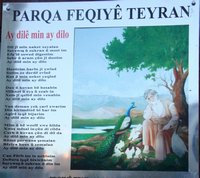 A second park is named after Ahmed-i Hani, another Kurdish writer who lived from 1650 to 1707 and who is buried in Doğubeyazıt, not far from the İshak Paşa Sarayı (palace).
A second park is named after Ahmed-i Hani, another Kurdish writer who lived from 1650 to 1707 and who is buried in Doğubeyazıt, not far from the İshak Paşa Sarayı (palace).
Van Kalesi (Van Castle, Rock of Van)
The shocking first sight that greets antiquity-loving visitors when they get out of the dolmuş to explore Van’s great Urartian castle is a glistening wall of white stone where part of the castle has been completely rebuilt.
Fortunately it’s a half-km walk from the dolmuş stop to the entrance gate which is long enough for the fury and frustration to have abated somewhat. What’s more the rebuilding has been restricted to one end of the castle so that if you could only manage to walk half that distance in a blindfold you would be able to fool yourself that nothing so awful had happened after all. I suspect more of the walls have been rebuilt since my last visit though.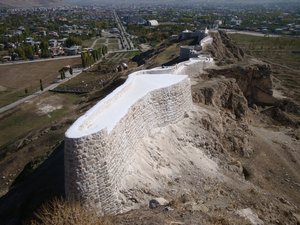
Van Kalesi is mostly a relic of the days when what is now Van was Tushpa, the capital of an Urartian kingdom centred on the lake that lasted from the 13th to the 7th century BC. The kingdom was famous for its wonderful metalwork, the best examples of which are now on display faraway in the Museum of Anatolian Civilisations in Ankara, much to the disgust of some locals.
The Urartians wrote in a form of cuneiform that they may have learnt from the Assyrians; there are fine examples of it on the sloping faces of the Rock of Van although you need to have a pretty good head for heights to inspect most of them. Excavations in 2012 also uncovered a Urartian palace within the castle.
On your way to the entrance you might want to pause to inspect a tomb which is a popular port of call for infertile women although you may well find it locked. Just inside the entrance you might also ask someone to unlock an attractive replica of an old Van house.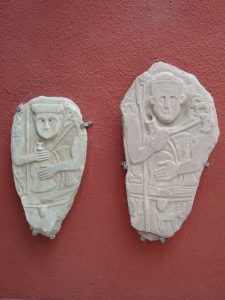
The Van Archaeology and Ethnography Museum (closed Mondays) can now be found on the road leading to the castle ticket office. It contains finds from and information about several Urartian sites in the area including Ayarış, in a breath-taking location right beside the lake, some 20 kilometers to the north. The star exhibits are 13 striking stelae found in distant Hakkari in 1998 and thought to date back to c.1,500 BC.
Around Old Van
The Rock of Van offers a spectacular view not just of Lake Van but also of the humps and bumps that mark the site of Old Van, the large Armenian quarter that vanished forever in 1915.
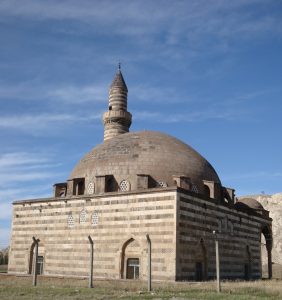 Locals picnic in the shadow of the rock on the Old Van side of it but there’s also a path that skirts the ruins and brings you out beside the wonderfully stripy Hüsrev Paşa Cami, an Ottoman structure dating back to 1567.
Locals picnic in the shadow of the rock on the Old Van side of it but there’s also a path that skirts the ruins and brings you out beside the wonderfully stripy Hüsrev Paşa Cami, an Ottoman structure dating back to 1567.
Just a short walk away is the equally attractive Kaya Çelebi Cami dating back to 1662. The Hüsrev Paşa complex has been restored (I believe it may have been damaged again by the 2011 earthquake); the Kaya Çelebi is locked up but if you peer through the door you’ll be able to admire its splendid mihrab.
When exploring here it might be wise to heed local warnings and do so in a group. It’s a very isolated area.
Van Cat Research Centre
A department of the Yuzuncu Yıl University’s Vetinerary Department, the Van Cat Research Centre has, since 1995, been working to preserve and breed pure white Van cats, either with one yellow and one blue eye, or with two eyes of the same colour. The Centre is out of town in the Bardakçı Mahallesi which is not especially easy to get to. Comments on visits suggest that you will not be allowed anywhere near the cats but will have to view them through a fence in which case it may be better to stop by the Van Kedi Evi on Melen Caddesi, the road back into town from the castle, which has more of a Cat Cafe vibe about it. I have not been to either personally.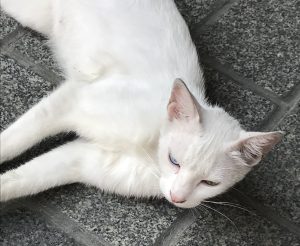
Sleeping
The 2011 earthquake felled two Van hotels including the long-lived Bayram. Since then several modern chain hotels have popped up to fill the gap.
Akdamar Hotel. Tel: 0432-214 9923
Büyük Asur Oteli. Tel: 0432-216 8792
Elite World Hotel. Tel: 0432- 484 1111
Hotel Merit Şahmaran, Edremit. Tel: 0432-312 3060
Eating
While in Van you should certainly forego your hotel breakfast one morning and head out with the locals to sample one of the many kahvaltı salonus (breakfast rooms) dotted about town. Indeed there are so many of them near the Yakut Hotel that Eski Sümerbank Sokak is now nicknamed Kahvaltı Sokak.
The most fun place certainly used to be Bak Hele Bak Yusuf Konağı, a kahvaltı sarayı (breakfast palace) no less, which was presided over with considerable verve by its owner Yusuf Bey, a man who obviously missed his vocation as a circus ringmaster. Your Turkish needed to be pretty robust to keep on top of the rhymes and riddles with which he blastsed all comers but everyone was able to appreciate the superb breakfast which cAme with fried eggs, herb-studded Van cheese, fresh pide bread and delectable balkaymak (cream and honey) to be washed down with lashings of tea. Since the earthquake it has moved to a new town-centre location in the Ali Paşa Mahallesi a little apart from the majority of places.
Travel info
Van airport (VAN) is west of town and, given the great distance from İstanbul or Ankara, the only really sensible way to get here is by plane. There are no airport transfer buses although there is a city bus if you don’t fancy paying for a taxi.
There are hourly buses to Van from Tatvan and regular minibuses from Doğubeyazıt.
There are also hourly buses south to Hakkari, passing Çavuştepe and Hoşap Kalesi.
Day trip destinations
Erçek Gölü


